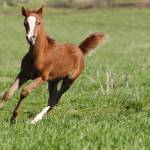Normal and Abnormal Long Bone Development in Young Horses

Long bones develop from cartilage by a process of endochondral (within cartilage) ossification. In the fetus, the bone anlages (early bone templates) are composed entirely of cartilage. The bone growth plates (physes) close at various stages. As a generalization, the ones nearest the foot (distal) close before the ones further up the leg (proximal). There is variation within each growth plate as well, and knowledge of these growth and closure patterns is critical to manipulation of deformities in the limb.
Ossification of the epiphyses at the ends of the long bones is also critical for an understanding of both joint development as well as defects in this ossification, such as osteochondrosis, one of the most important conditions of which is osteochondritis dissecans (OCD). Ossification of the epiphysis requires blood vessels and these are provided through cartilage canals. Prior to ossification, the cartilage that contains cartilage canals and blood vessels is called epiphyseal cartilage. Cartilage that remains at the end of ossification and lines the joint is called articular (joint) cartilage and is devoid of blood vessels. It also has a very specific structure to provide motion at the joint surface. The anatomy of the metaphyesal growth plate or physis is quite complicated.
Various abnormalities may be involved in the developmental process. They are generally classified under the term “developmental orthopedic disease” (DOD). These abnormalities may involve defects in endochondral ossification by which the bone is formed; abnormalities in bone lengthening; or metabolic changes within the bone after it is formed. The cause of these problems is often multifactorial and may involve genetics, feed management, mineral imbalances, exercise, disturbances in the smooth plane of growth and weight gain, accidental injury, and other factors. Many of these abnormalities in bone maturation are not identified until the young horse goes into training.
Many of these conditions are seen only at an end stage. For instance, chip fractures in the carpus of the racehorse are secondary to long-term degenerative conditions in the subchondral bone. Similarly, stress fractures in the racing athlete are probably not an acute event but rather a final breakdown in bone structure due to localized osteoporosis associated with bone remodeling. The early signs of abnormal bone development may not be noticed until the abnormality becomes severe enough to cause catastrophic injuries.
To keep horses as sound and healthy as possible and to avoid acute injury, owners and trainers should pay attention to the first signs of pain, stiffness, or uneven gaits and should back off the intensity of training, allowing the horse to rest and recover. This may help to minimize the incidence of serious and possibly career-ending breakdowns in young racehorses.








